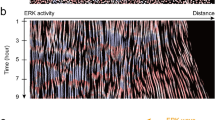Abstract
We propose to study the wound healing in Zebrafish by using firstly a differential approach for modelling morphogens diffusion and cell chemotactic motion, and secondly a hybrid model of tissue regeneration, where cells are considered as individual objects and molecular concentrations are described by partial differential equations.














Similar content being viewed by others
References
Alfaro M (2006) Systèmes de convection–réaction–diffusion et dynamique d’interface. Thesis, University Paris Sud
Araújo SJ (2015) The hedgehog signalling pathway in cell migration and guidance: what we have learned from Drosophila melanogaster. Cancers 7(2):2012–2022
Blaschko A (1901) Die Nervenverteilung in der Haut in ihrer Beziehung zu den Erkrankungen der Haut. Bericht from VII Congress der Deutschen Dermatologischen Gesellschaft, Breslau
Borges AF (1984) Relaxed skin tension lines (RSTL) versus other skin lines. Plast Reconstr Surg 73(1):144–150
Chuong CM (1998) Molecular basis of epithelial appendage morphogenesis. Landes Company, Austin
Dhouailly D, Olivera-Martinez I, Fliniaux I, Missier S, Viallet JP, Thélu J (2004) Skin field formation: morphogenetic events. Int J Dev Biol 48(2–3):85–91
Friedman A, Xue C (2011) A mathematical model for chronic wound. Math Biosci Eng 8(2):253–261
Huh SH, Närhi K, Lindfors PH, Häarä O, Yang L, Ornitz DM, Mikkola ML (2013) Fgf20 governs formation of primary and secondary dermal condensations in developing hair follicles. Genes Dev 27(4):450–458
Iwamoto M, Ueyama D, Kobayashi R (2014) The advantage of mucus for adhesive locomotion in gastropods. J Theor Biol 353:133–141
James R (1993) Linear skin rashes and the meridians of acupuncture. Eur J Orient Med 1(1):42–46
Keller EF, Segel LA (1970) Initiation of slime mold aggregation viewed as an instability. J Theor Biol 26:399–415
Kraissl CJ (1951) The selection of appropriate lines for elective surgical incisions. Plast Reconstr Surg (1946) 8(1):1–28
Michon F, Forest L, Collomb E, Demongeot J, Dhouailly D (2008) Bmp2 and bmp7 play antagonistic roles in feather induction. Development 135(16):2797–2805
Murray JD (1989) Mathematical biology. Springer, Berlin
Olivera-Martinez I, Viallet JP, Michon F, Pearton DJ, Dhouailly D (2004) The different steps of skin formation in vertebrates. Int J Dev Biol 48:107–116
Oster GF, Murray JD, Maini PK (1985) A model for chondrogenic condensations in the developing limb. J Embryol Exp Morphol 89(11):93–112
Perthame B, Dalibard AL (2009) Existence of solutions of the hyperbolic Keller-Segel model. Trans Am Math Soc 361(5):2319–2335
Postlethwaite AE, Keski-Oja J, Balian G, Kang AH (1981) Induction of fibroblast chemotaxis by fibronectin. Localization of the chemotactic region to a 140,000-molecular weight non-gelatin-binding fragment. J Exp Med 153(2):494–499
Ridge MD, Wright V (1966) The directional effects of skin. A bio-engineering study of skin with particular reference to Langer’s lines. J Invest Dermatol 46(4):341–346
Sgonc R, Gruber J (2013) Age-related aspects of cutaneous wound healing: a mini-review. Gerontology 59(2):159–164
Shaw AC, Goldstein DR, Montgomery RR (2013) Age-dependent dysregulation of innate immunity. Nat Rev Immunol 13(12):875–887
Sire JY, Akimenko MA (2004) Scale development in fish: a review, with description of sonic hedgehog (shh) expression in the zebrafish (danio rerio). Int J Dev Biol 48(2–3):233–247
Thibault MM, Hoemann CD, Buschmann MD (2007) Fibronectin, vitronectin, and collagen I induce chemotaxis and haptotaxis of human and rabbit mesenchymal stem cells in a standardized transmembrane assay. Stem Cells Dev 16(3):489–502
Tracqui P, Ohayon J (2004) Transmission of mechanical stresses within the cytoskeleton of adherent cells: a theoretical analysis based on a multi-component cell model. Acta Biotheor 52(4):323–341
Tracqui P, Namy P, Ohayon J (2005) Cellular networks morphogenesis induced by mechanically stressed microenvironments. J Biol Phys Chem 5(2–3):57–69
Tranquillo RT, Murray J (1992) Continuum model of fibroblast-driven wound contraction: inflammation-mediation. J Theor Biol 158(2):135–172
Viallet J, Prin F, Olivera-Martinez I, Hirsinger E, Pourquie O, Dhouailly D (1998) Chick delta-1 gene expression and the formation of the feather primordia. Mech Dev 72(1):159–168
Wilhelmi BJ, Blackwell SJ, Phillips LG (1999) Langer’s lines: to use or not to use. Plast Reconstr Surg 104(1):208–214
Zallen JA (2007) Planar polarity and tissue morphogenesis. Cell 129(6):1051–1063
Author information
Authors and Affiliations
Corresponding author
Electronic supplementary material
Below is the link to the electronic supplementary material.
Rights and permissions
About this article
Cite this article
Caraguel, F., Bessonov, N., Demongeot, J. et al. Wound Healing and Scale Modelling in Zebrafish. Acta Biotheor 64, 343–358 (2016). https://doi.org/10.1007/s10441-016-9298-8
Received:
Accepted:
Published:
Issue Date:
DOI: https://doi.org/10.1007/s10441-016-9298-8




